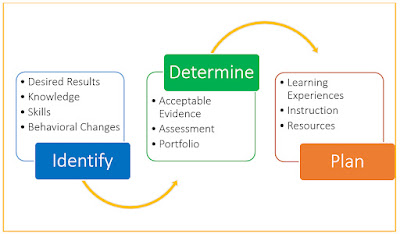Implementation of The Backward Design (BD) to Support and Guide Curriculum Decisions
Backward design
BD requires
- Identify desired results, specifying the expected outcomes.
- Determine acceptable evidence and appoint adequate proof of achieved developments.
- Plan learning experiences, instruction, and resources. It also supports teaching and resources to reach the learning outcomes (Washington State University, 2019).
Identifying the Heart of the Issue As Designing a "Content-Centred" Course
Prioritizing makes us see a structure emerging that may not be in the same order or with the same emphasis as before. Asking questions like the following can help sort and prioritize:
- What to include for students to have the required knowledge and skills to continue in the discipline?
- Either to include it only because it is in the textbook or not?
- What to include in the course as central to the discipline?
- If to include materials because the person who taught this course before included them?
Educational Innovation at UW-Madison: The "Backward Design" Framework
"Liberal education, on the other hand, focuses on a two-pronged approach exposing students to broad knowledge of many disciplines as well as deep knowledge within a particular field of study, with the intention of developing flexible communication, intellectual, and decision- making skills" (Michael & Libarkin, 2016, p44).
References
Amer, R. (2022). Characteristics of Effective Learning.
Brown, P. C., Roediger, H. L., & McDaniel, M. A. (2014). Learning is misunderstood. In Make it stick (pp. 1-22). Cambridge, MA: Belknap.
Donovan, M. S., Bransford, J. D., & Pellegrino, J. W. (2002). Key findings. In How people learn: Bridging research & practice (pp. 10-24). National Academy Press.
Fink, L. Dee (2013) "The Current Status of Faculty Development Internationally," International Journal for the Scholarship of Teaching and Learning, 7(2), Article 4. Available at: https://doi.org/10.20429/ijsotl.2013.070204
Michael, N.A. & Libarkin, J.C.. (2016). Understanding by design: Mentored implementation of backward design methodology at the university level. Bioscene, 42(2). 44-52.
Washington State University. (September 6, 2019). Backward Design: A Planning Framework. Academic. Outreach and Innovation | Learning Innovations.


No comments:
Post a Comment